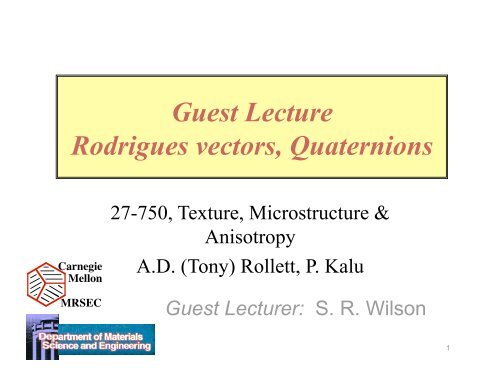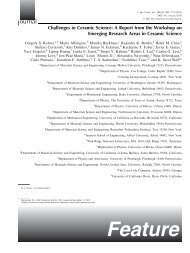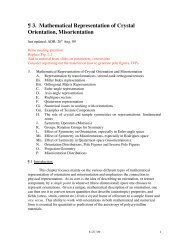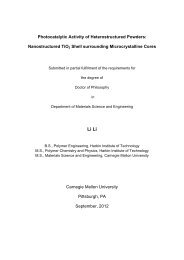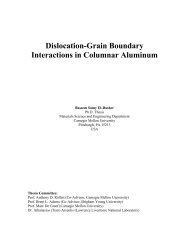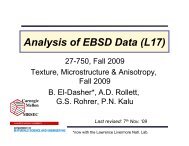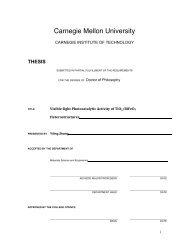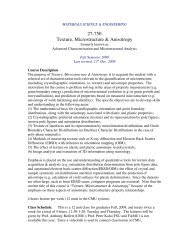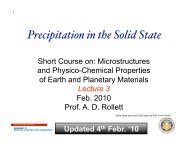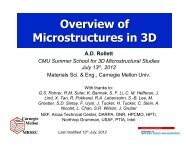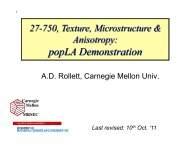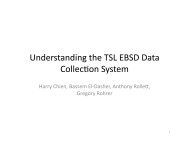Guest Lecture Rodrigues vectors, Quaternions
Guest Lecture Rodrigues vectors, Quaternions
Guest Lecture Rodrigues vectors, Quaternions
Create successful ePaper yourself
Turn your PDF publications into a flip-book with our unique Google optimized e-Paper software.
Carnegie<br />
Mellon<br />
MRSEC<br />
<strong>Guest</strong> <strong>Lecture</strong><br />
<strong>Rodrigues</strong> <strong>vectors</strong>, <strong>Quaternions</strong><br />
27-750, Texture, Microstructure &<br />
Anisotropy<br />
A.D. (Tony) Rollett, P. Kalu<br />
<strong>Guest</strong> <strong>Lecture</strong>r: S. R. Wilson<br />
1
Briefly describe rotations/orientations<br />
Introduce <strong>Rodrigues</strong>-Frank <strong>vectors</strong><br />
Introduce quaternions<br />
Objectives<br />
Learn how to manipulate and use quaternions<br />
as rotation operators<br />
Discuss conversions between Euler angles,<br />
rotation matrices, RF <strong>vectors</strong>, and quaternions
Why do we need to learn about<br />
orientations and rotations?<br />
g A<br />
Orientation distributions: Define single-grain<br />
orientations relative sample reference frame, and<br />
take symmetry into account.<br />
g S<br />
g B
Why do we need to learn about<br />
orientations and rotations?<br />
g A<br />
Δg AB = g B g A −1<br />
Misorientation distributions: Compare orientations on<br />
either side of grain boundaries to determine boundary<br />
character.<br />
MISORIENTATION : The rotation required to transform from<br />
the coordinate system of grain A to grain B<br />
g S<br />
g B
Review: Euler angles<br />
Euler angles:<br />
ANY rotation can be written<br />
as the composition of at most 3<br />
very simple rotations.<br />
R(φ 1 ,Φ,φ 2 ) = R(φ 2 )R(Φ)R<br />
(φ 1 )<br />
Once the Euler angles are<br />
known, rotation matrices for any<br />
rotation are therefore straightforward<br />
to compute.<br />
z-x-z rotation sequence<br />
Movie credit: Wikipedia
Review: Euler angles<br />
Difficulties with Euler angles:<br />
Non-intuitive, difficult to visualize.<br />
There are 12 different possible<br />
axis-angle sequences. The<br />
“standard” sequence varies from<br />
field to field, and even within fields.<br />
Every rotation sequence contains<br />
at least one artificial singularity,<br />
where Euler angles do not make<br />
sense, and which can lead to<br />
numerical instability in nearby<br />
regions.<br />
Operations involving rotation<br />
matrices derived from Euler angles<br />
are not nearly as efficient as<br />
quaternions.<br />
z-x-z rotation sequence<br />
Movie credit: Wikipedia
We want to be able to<br />
quantify transformations<br />
between coordinate<br />
systems<br />
“Passive” rotations:<br />
Given the coordinates<br />
(v x ,v y ,v z ) of vector v in<br />
the black coordinate<br />
system, what are its<br />
coordinates (v x ,v y ,v z ) in<br />
the red system?<br />
Passive rotations<br />
Unit sphere
We want to be able to<br />
quantify transformations<br />
between coordinate<br />
systems<br />
“Active” rotations:<br />
Given the coordinates<br />
(v x ,v y ,v z ) of vector v in the<br />
black coordinate system,<br />
what are the coordinates<br />
(w x ,w y ,w z ) of the rotated<br />
vector w in the black<br />
system?<br />
Active rotations<br />
Unit sphere<br />
Passive / Active : “only a minus sign”<br />
difference, but it is very important
We also need to describe<br />
how to quantify and<br />
represent the rotation that<br />
relates any two<br />
orientations<br />
An orientation may be<br />
represented by the<br />
rotation required to<br />
transform from a specified<br />
reference orientation<br />
(sample axes)<br />
Basics, reviewed<br />
Unit sphere<br />
We need to be able to quantitatively represent and<br />
manipulate 3D rotations in order to deal with<br />
orientations
How to relate two orthonormal<br />
First pick a direction<br />
represented by a<br />
unit normal r<br />
Two numbers related to<br />
the black system are<br />
needed to determine r<br />
bases?<br />
(i.e. r x and r y , or latitude and longitude,<br />
or azimuthal and polar angles)<br />
Unit sphere
How to relate two orthonormal<br />
To specify an orthonormal<br />
basis, one more number is<br />
needed (such as an angle<br />
in the plane perpendicular<br />
to r)<br />
Three numbers<br />
are required to<br />
describe a<br />
transformation<br />
from the black<br />
basis to the red<br />
basis<br />
bases?<br />
Unit sphere<br />
. . .the “right hand rule”<br />
and orthogonality<br />
determine the position of<br />
third basis vector.
Any rotation may therefore<br />
be characterized by an axis r<br />
and a rotation angle α about<br />
this axis R(r, α )<br />
“axis-angle” representation<br />
The RF representation<br />
instead scales r by the<br />
tangent of α/2<br />
ρ = ˆ<br />
r tan α /2<br />
( )<br />
Note semi-angle<br />
<strong>Rodrigues</strong> <strong>vectors</strong>
<strong>Rodrigues</strong> <strong>vectors</strong><br />
<strong>Rodrigues</strong> <strong>vectors</strong> were popularized by Frank [“Orientation<br />
mapping.” Metall. Trans. 19A: 403-408 (1988)], hence the<br />
term <strong>Rodrigues</strong>-Frank space for the set of <strong>vectors</strong>.<br />
Most useful for representation of misorientations, i.e. grain<br />
boundary character; also useful for orientations (texture<br />
components).<br />
Application to misorientations is popular because the<br />
<strong>Rodrigues</strong> vector is so closely linked to the rotation axis,<br />
which is meaningful for the crystallography of grain<br />
boundaries.<br />
13
€<br />
€<br />
The rotation axis, r, is obtained from the skew-symmetric part of the matrix:<br />
Another useful relation gives us the magnitude of the rotation, θ, in terms of<br />
the trace of the matrix, a ii :<br />
, therefore,<br />
ˆ<br />
r =<br />
2<br />
aii = 3cosθ + (1− cosθ)n i =1+ 2cosθ<br />
cos θ = 0.5 (trace(a) – 1).<br />
(a 23 − a 32),(a 31 − a 13),(a 12 − a 21)<br />
(a 23 − a 32) 2 + (a 31 − a 13) 2 + (a 12 − a 21) 2<br />
See the slides on Rotation_matrices for what to do when you have small<br />
angles, or if you want to use the full range of 0-360° and deal with switching<br />
the sign of the rotation axis. Also, be careful that the argument to arc-cosine<br />
is in the range -1 to +1 : round-off in the computer can result in a value<br />
outside this range.<br />
14
€<br />
15<br />
Conversions: matrix→RF vector<br />
Conversion from rotation (misorientation)<br />
matrix, due to Morawiec, with<br />
∆g AB =g B g A -1 :<br />
⎛ ρ ⎞ 1<br />
⎜ ⎟<br />
⎜<br />
ρ2⎟ ⎜ ⎟<br />
⎝ ρ3⎠ =<br />
⎡ [Δg(2,3) − Δg(3,2)]/ [ 1+ tr(Δg) ] ⎤<br />
⎢<br />
⎥<br />
⎢ [Δg(3,1) − Δg(1,3)]/ [ 1+ tr(Δg) ] ⎥<br />
⎣ ⎢ [Δg(1,2) − Δg(2,1)]/ [ 1+ tr(Δg) ] ⎦ ⎥<br />
Morawiec, A. (2003). Orientations and Rotations.<br />
Berlin, Springer.
17<br />
Conversion <strong>Rodrigues</strong> vector to<br />
axis transformation matrix<br />
• Due to Morawiec:<br />
a ij =<br />
1<br />
1+ ρ lρ l<br />
( [ 1− ρlρ l ]δij + 2ρiρ j + 2εijkρ )<br />
k
18<br />
Combining Rotations as RF <strong>vectors</strong><br />
• Two <strong>Rodrigues</strong> <strong>vectors</strong> combine to form a third,<br />
ρ C , as follows, where ρ B follows after ρ A . Note<br />
that this is not the parallelogram law for<br />
<strong>vectors</strong>!<br />
ρ C = (ρ A , ρ B ) =<br />
{ρ A + ρ B - ρ A x ρ B }/{1 - ρ A •ρ B }<br />
addition<br />
vector product scalar product
19<br />
ρ 1<br />
Combining Rotations as RF<br />
<strong>vectors</strong>: component form<br />
( C C<br />
,ρ2 ,<br />
C)<br />
ρ3 =<br />
⎛<br />
⎜<br />
⎜<br />
⎜<br />
⎜<br />
⎝<br />
ρ<br />
A<br />
+ 1<br />
ρ1<br />
ρ<br />
A<br />
+ 2<br />
ρ2<br />
1 − ρ 1<br />
[ ⎞<br />
],<br />
⎟<br />
[<br />
⎟<br />
A B<br />
ρ1 −<br />
A B<br />
ρ1 ρ3 ], ⎟<br />
⎟<br />
A B<br />
ρ2 −<br />
A B ⎟ ρ2 ρ1 ⎠<br />
B<br />
−<br />
A B<br />
ρ2 ρ3 −<br />
A B<br />
ρ3 ρ2<br />
B − ρ3<br />
[ ]<br />
ρ<br />
A<br />
+<br />
B<br />
3<br />
ρ3 − ρ1<br />
( A B<br />
ρ1 +<br />
A B<br />
ρ2 ρ2 +<br />
A B)<br />
ρ3 ρ3
<strong>Quaternions</strong>: Yet another<br />
representation of rotations<br />
What is a quaternion?<br />
A quaternion is first of all an ordered set<br />
of four real numbers q0 , q1 , q2 , and q4 .<br />
Here, i, j, k are the familiar unit <strong>vectors</strong><br />
that correspond to the x-, y-, and z-axes,<br />
Scalar part Vector part<br />
resp.<br />
Addition of two quaternions and multiplication of a<br />
quaternion by a real number are as would be<br />
expected of normal four-component <strong>vectors</strong>.<br />
Magnitude of a quaternion:<br />
Conjugate of a quaternion:
Multiplication of two quaternions<br />
However, quaternion multiplication is<br />
ingeniously defined in such a way so as<br />
to reproduce rotation composition.<br />
Multiplication of the basis<br />
quaternions is defined as follows:<br />
From these rules it can be<br />
shown that the product of two<br />
arbitrary quaternions p,q is<br />
given by:<br />
Using more compact notation:<br />
[1] Quaternion multiplication is<br />
non-commutative (pq≠qp).<br />
[2] There are similarities to<br />
complex numbers (which<br />
correspond to rotations in 2D).<br />
Scalar part Vector part
Unit quaternions as rotations<br />
We state without proof that a rotation of α degrees<br />
about the (normalized) axis r may be represented by<br />
the following unit quaternion:<br />
It is easy to see that this is a unit quaternion, i.e. that<br />
Note the similarity to <strong>Rodrigues</strong> <strong>vectors</strong>.<br />
For two rotations q and p that share a single axis r, note what<br />
happens when q and p are multiplied:
Multiplication of a quaternion<br />
and a 3-D vector<br />
It is useful to define the multiplication of <strong>vectors</strong><br />
and quaternions as well. Vectors have three<br />
components, and quaternions have four. How to<br />
proceed?<br />
Every vector v corresponds to a “pure”<br />
quaternion whose 0 th component is<br />
zero.<br />
…and proceed as with two quaternions:<br />
Note that in general that the product of a quaternion and a<br />
vector can result in a non-pure quaternion with non-zero<br />
scalar component.
Rotation of a vector<br />
by a unit quaternion<br />
Although the quantity qv may not be a vector, it<br />
can be shown that the triple products q*vq and<br />
qvq* are.<br />
In fact, these <strong>vectors</strong> are the images of v by<br />
passive and active rotations corresponding to<br />
quaternion q.<br />
Passive rotation<br />
Active rotation
Rotation of a vector<br />
by a unit quaternion<br />
Expanding these expressions yields<br />
Moreover, the composition of two<br />
rotations (one rotation following another)<br />
is equivalent to quaternion multiplication.<br />
Passive rotation<br />
Active rotation<br />
since
Example: Rotation of a Vector by<br />
Quaternion-Vector Multiplication<br />
Consider rotating the vector i by an<br />
angle of α = 2π/3 about the <br />
direction.<br />
i<br />
k<br />
For a passive rotation:<br />
j<br />
Rotation axis:<br />
For an active rotation:
27<br />
€<br />
Formulae, due to Morawiec:<br />
Note: passive rotation/<br />
axis transformation<br />
(axis changes sign for<br />
for active rotation)<br />
cosθ = 1 1+ tr Δg<br />
2 2 ( ) ≡ q4 = ±<br />
q i = ±<br />
ε ijk Δg jk<br />
( )<br />
4 1+ tr Δg<br />
1+ tr( Δg)<br />
2<br />
⎛ q ⎞ ⎡ ±[Δg(2,3) − Δg(3,2)]/2 1+ tr Δg<br />
1<br />
⎜ ⎟ ⎢<br />
⎜<br />
q2⎟ ⎢ ±[Δg(3,1) − Δg(1,3)]/2 1+ tr Δg<br />
€ =<br />
⎜ q ⎟ ⎢<br />
3 ±[Δg(1,2) − Δg(2,1)]/2 1+ tr Δg<br />
⎜ ⎟ ⎢<br />
⎝ q4⎠ ⎣<br />
⎢ ± 1+ tr( Δg)<br />
/2<br />
Note the coordination of choice of sign!<br />
( )<br />
( )<br />
( )<br />
⎤<br />
⎥<br />
⎥<br />
⎥<br />
⎥<br />
⎦<br />
⎥
28<br />
References<br />
Frank, F. (1988). “Orientation mapping,” Metallurgical Transactions<br />
19A: 403-408.<br />
P. Neumann (1991). “Representation of orientations of symmetrical<br />
objects by <strong>Rodrigues</strong> <strong>vectors</strong>.” Textures and Microstructures 14-18:<br />
53-58.<br />
Takahashi Y, Miyazawa K, Mori M, Ishida Y. (1986). “Quaternion<br />
representation of the orientation relationship and its application to grain<br />
boundary problems.” JIMIS-4, pp. 345-52. Minakami, Japan: Trans.<br />
Japan Inst. Metals. (1st reference to quaternions to describe grain<br />
boundaries).<br />
A. Sutton and R. Balluffi (1996), Interfaces in Crystalline Materials,<br />
Oxford.<br />
V. Randle & O. Engler (2000). Texture Analysis: Macrotexture,<br />
Microtexture & Orientation Mapping. Amsterdam, Holland, Gordon &<br />
Breach.<br />
S. Altmann (2005 - reissue by Dover), Rotations, <strong>Quaternions</strong> and<br />
Double Groups, Oxford.<br />
A. Morawiec (2003), Orientations and Rotations, Springer (Europe).


